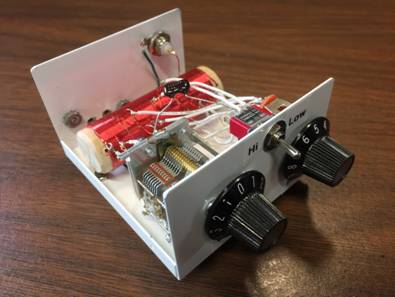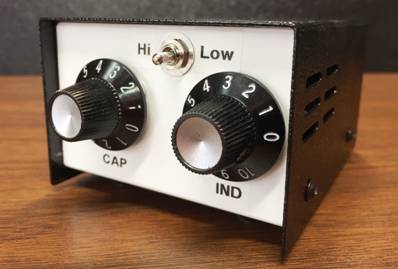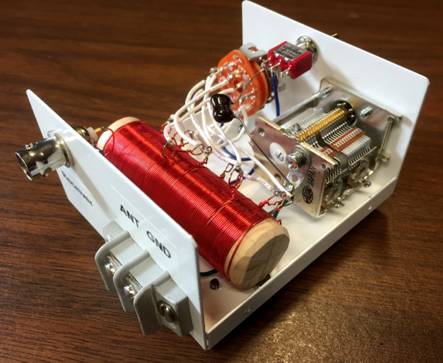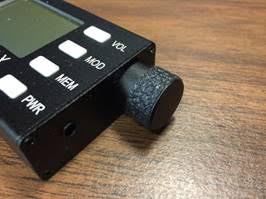 Many thanks to SWLing Post contributor, Steve Allen (KZ4TN), who shares the following guest post:
Many thanks to SWLing Post contributor, Steve Allen (KZ4TN), who shares the following guest post:
A Simple Antenna Tuner for SWL Radios
by Steve Allen, KZ4TN
After reading 13DKA’s excellent review of the Belka-DSP on SWLing.com a few weeks ago I knew I had to have one! The size, features, and performance of the Belka-DX (latest version of the Belka-DSP) is phenomenal. I won’t go into reviewing the radio as I couldn’t come close to 13DKA extensive review. If you are considering this SWL receiver his review is a must read.
I love bedtime SWLing and have been putting off setting up an outside antenna specifically to feed into the bedroom for too long. Given that the resonant frequency of the antenna would not be broad enough for the tuning range of the Belka-DX I decided to build a small antenna tuner just for SWLing.
After a couple of hours searching the internet for a simple tuner I found just what I was looking for on http://www.hard-core-dx.com/nordicdx/antenna/lab/tuner.html. It’s a simple L match using a single variable capacitor and coil.
For the coil I wound ~100 turns of 26 Ga wire on a one inch diameter wooden dowel. The wire size can be whatever you have on hand. I twisted a tap every 10 turns. I drilled a hole in each end and glued in a machine screw to mount the coil to the bottom of the enclosure. I’ve had this enclosure in my junk box for a long time and have been waiting for just the right project. The variable capacitor I used was one I found on EBay a few years ago that had two sections, 330 pF and 120 pF. I tied them together for 450 pF. For the rotary switch I had to scratch around on eBay for a while until I found a 12 position single pole.
The plans for the tuner suggested adding a fixed value capacitor with a toggle switch to increase the lower end of the tuning range. I found a 510 pF silver mica and wired it into the circuit.
The antenna I put up is a sloper about 30 feet long.The high end is up about 40 feet and the low end is at about 12 feet. I put the antenna and tuner to the test last evening and the reception on the Belka-DX was superb. With the tuner the strength of the signal would peak about 2-3 units when I found the sweet spot.
The tuner also does double duty as an attenuator for very strong signals.
One mod I made to the Belka-DX was the addition of some grip tape to the tuning knob. It makes fine tuning much easier.
I believe we will continue to see a number of innovative receivers coming to market in the near term utilizing SDR technology. The ratio of performance to size of the Belka-DX is truly amazing in my opinion.
Thank you, Steve, for sharing this brilliant weekend project! As always, brilliant craftsmanship!




Hi Steve..it is a good project and I made it with your help..But I wanna ask sth.I found a 50-360 pf variable..is it usable or not?I will only use it listening sw not transmitting.. Thanks from Turkey..Also
Thanks for your kind words, Steve! A simple tuner is really all that’s needed to run the Belka with just about anything that could be used as an antenna.
The Belka seems to be a bit odd when it comes to external antennas, I believe this is due to the input being so optimized for the whip. I found it’s quite indifferent to external antennas and particularly random wires, it just works fine with anything putting out some voltage and anything “active”. But it almost stops working with a NCPL (YouLoop (Möbius loop)) or a whip on a magmount, I that’s where a tuner (some comment even said a variable C will suffice) can improve that a lot.
also see
http://techlib.com/electronics/antennas.html
for some additional ideas 😉
Nice build and a nice addition to whatever receiver; just some notes, first of all, since it’s an RX only thing, the variable capacitor may be replaced by a cheap polyvaricon which may even be recovered from some old “pocket” receiver and which will serve you as well as the air variable you used, second, you may consider adding a simple low gain preamplifier stage to the design, just place the preamp between the tuner and the rx and you should be fine; third (and optional) willing to further improve the design, it may be possible building some preselector boards using this design https://www.robkalmeijer.nl/techniek/electronica/radiotechniek/hambladen/qst/1991/12/page29/index.html and switch them to match the desired band, that would give you antenna matching AND band filtering; in this latter case, the preamp should be placed at the output of the preselector(s)
Great link! I have wanted to build a receiving mag loop for some time now.
I recently purchased the W2LI mag loop for 40, 30, 20 meters. It’s my first experience with mag loop antennas and I have been very impressed with it’s performance transmitting and receiving.
I just spent some time scouring Ebay for a used cheap AM radio to hack and rebuild into a tuner for the Belka as part on my ultra-light backpacking radio SWL kit.
I’m also looking into building a QRPsubP transmitter to go with the Belka. This receiver has so much potential.
Thanks Andrew.
You, sir, have inspired me to build a similar tuner. I had thought about purchasing the Emtech ZM-2 kit, but I like the idea of this one as well. Thanks for sharing your project.
In my opinion a “preselector” would be preferable over an antenna tuner. An antenna tuner does increase the signal but also increases any noise on or near the frequency you are tuned to. A preselector will generally minimize birdies, noise etc on either side of the frequency you are tuned to. A preselector is more difficult to construct and/or purchase
Thanks for the suggestion. I wanted to keep the tuner passive to cut down on power need. While the tuner does increase the noise level at certain settings, I have found that it can actually provide signal clarity while at the same time reducing background noise. While I only recently purchased the Belka-DX, I have not had the chance to listen during the summer months with the inherently strong atmospheric noise.
Nice straightforward l-network build. 🙂
For those seeking a similar off-the-shelf alternative, take a look for the MFJ 16010 tuner on the used market. Note at full retail there a better solutions for similar or slightly more money, or often better yet, spend the money on improving your antenna farm.
Also, admittedly, I sometimes tend to be a little more lazy in my approach by just tossing a preamp inline in such situations. YMMV.